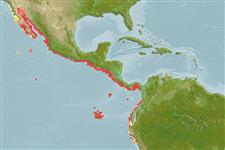Environment: milieu / climate zone / depth range / distribution range
Ecology
Marine; demersal; depth range 50 - 130 m (Ref. 9342). Tropical; 33°N - 9°S, 118°W - 76°W (Ref. 5222)
Eastern Pacific: southern California to Peru. Misidentified as Epinephelus niveatus by some authors (Ref. 5995, 6852).
Size / Weight / Age
Maturity: Lm ? range ? - ? cm
Max length : 48.0 cm SL male/unsexed; (Ref. 5222)
Dorsal spines (total): 11; Dorsal soft rays (total): 13 - 15; Anal spines: 3; Anal soft rays: 9. Distinguished by the following characteristics: juveniles dark reddish brown with white spots in grid-like pattern of vertical series and horizontal rows on body and dorsal fin; caudal peduncle with visible dark saddle blotch; pale caudal and pectoral fins; dark brown anal and pelvic fins; black maxillary groove; adults dark brown lacking white spots; depth of body contained 2.3-2.7 times in SL; head length 2.2-2.5 times in SL; convex interorbital area; slightly produced angle of preopercle, with enlarged serrae; distinctly convex upper edge of operculum; vertically elongate posterior nostrils, 2-5 times larger than anterior nostrils; maxilla reaches to or beyond vertical at rear edge of eye; 2 rows of teeth on midlateral part of lower jaw (Ref. 89707).
Found on rocky reefs and soft bottoms (Ref. 89707). Reported to be often caught in shrimp trawls in central Gulf of California. Too rare to be of commercial interest.
Life cycle and mating behavior
Maturity | Reproduction | Spawning | Eggs | Fecundity | Larvae
Craig, M.T. and P.A. Hastings, 2007. A molecular phylogeny of the groupers of the subfamily Epinephelinae (Serranidae) with revised classification of the epinephelini. Ichthyol. Res. 54:1-17. (Ref. 83414)
IUCN Red List Status (Ref. 130435: Version 2024-1)
Threat to humans
Harmless
Human uses
Fisheries: subsistence fisheries; gamefish: yes
Tools
Special reports
Download XML
Internet sources
Estimates based on models
Preferred temperature (Ref.
123201): 15.6 - 23.1, mean 17.2 °C (based on 19 cells).
Phylogenetic diversity index (Ref.
82804): PD
50 = 0.5001 [Uniqueness, from 0.5 = low to 2.0 = high].
Bayesian length-weight: a=0.01349 (0.00621 - 0.02932), b=3.03 (2.86 - 3.20), in cm total length, based on LWR estimates for this Genus-body shape (Ref.
93245).
Trophic level (Ref.
69278): 3.8 ±0.7 se; based on size and trophs of closest relatives
Resilience (Ref.
120179): Medium, minimum population doubling time 1.4 - 4.4 years (Preliminary K or Fecundity.).
Fishing Vulnerability (Ref.
59153): Moderate vulnerability (43 of 100).
Nutrients (Ref.
124155): Calcium = 99.3 [39.1, 183.2] mg/100g; Iron = 0.847 [0.447, 1.672] mg/100g; Protein = 18 [16, 20] %; Omega3 = 0.274 [0.161, 0.485] g/100g; Selenium = 56.8 [28.6, 119.5] μg/100g; VitaminA = 29.4 [9.3, 106.2] μg/100g; Zinc = 0.892 [0.613, 1.347] mg/100g (wet weight);
